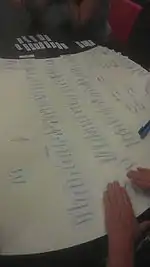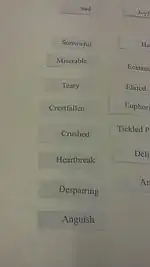Tutorial 04: Emotion
| Resource type: this resource contains a tutorial or tutorial notes. |
This is the fourth tutorial for the Motivation and emotion unit of study.
Core emotion sort


The goal of this exercise is to organise emotion-related words into a model which depicts underlying families of emotional experience.
Core emotion criteria
What are the criteria for a core emotion?
To qualify as a core emotion, consider whether an affective state is/has a:
- Distinct physiological/neurology response? (e.g., neurological activation, hear-rate)
- Distinct feeling? (subjective/phenomenological state)
- Unique expression? (e.g., unique facial expression and body language)
- Innate? (i.e., evident from birth)
- Adaptive purpose/function?
- Short-lived (vs. moods which are longer-lived)
- Triggered by same circumstances each time? (i.e., has a specific causal trigger)?
- Universal (i.e., recognised by different cultures)
Non-emotions
There are several affective psychological experiences which do not qualify as emotions and may instead be better considered as:
- Attitudes (e.g., hate)
- Behaviours (e.g., aggression)
- Cognitions (e.g., confused)
- Disorders (e.g., behavioural conduct disorder)
- Moods (e.g., grumpy)
- Personality traits (e.g., neuroticism)
Steps
- Face-to-face
- In small groups, cut up the list of emotion words - need scissors and lots of table space
- Sort the emotion words:
- sort those which represent emotions into core emotion families - try not to be restricted or overly-guided by previous theory - go with what seems to make sense.
- discard those which do not represent core emotion families
- Label each emotion family
- Share and discuss your group's model with the rest of the class
- Virtual
- Go to the online list of emotion words
- As a group, work through each emotion word, classifying as either a:
- member of a core emotion family
- non-emotion word
- After the initial classification, sort and review the words by emotion family
- Discuss the results
Emotion knowledge
This core emotion sort exercise is also designed to expand "emotion knowledge", which is the "number of different emotions any one person can distinguish" (e.g., various shades of anger) which is part of emotional literacy and emotional intelligence. Emotion knowledge can be improved by expanding one's linguistic repertoire for describing emotions. Reeve (2009, p. 353) suggests that "the finer and more sophisticated one's emotion knowledge is, the greater his or her capacity to respond to each life event with a specialised and highly appropriate reaction".
Foreign language emotion words
There are many non-English words for emotional states that are not so well described in English e.g.,:
Measuring emotion: PANAS
| Search for Positive and Negative Affect Schedule on Wikipedia. |
- Complete and score the 20-item Positive and Negative Affect Schedule (PANAS; Watson & Clark, 1999):
- Hard-copy handout
- Online version (PsyToolkit)
- Compare scores with norms
- Table 1, Watson et al., 1988; SMU, N = 660:
- Positive Affect (PA) M = 29.7
- Negative Affect (NA) M = 14.8
- Table 2, Watson & Clark (1994):
- PA M = 35.7
- NA M - 19.5
- Table 1, Watson et al., 1988; SMU, N = 660:
- Discuss:
- Versions
- Temporal framing
- Short vs. long (PANAS-X)
- Psychometrics
- Correlation between PA and NA
- Test-retest reliability
- Versions
- See also: Affect measures (Wikipedia)
Book chapter development
- Watchlist
- Preferences e.g., email notifications
- Thanking
- Undoing changes (via History)
- Quizzes
- Pretty boxes
Recording
- Tutorial 04 recording, 2019
- Tutorial 04 recording, 2016
See also
- Tutorial session notes - Instructor notes
- Emotional intelligence (Additional tutorial exercise)
- Goals and self (Previous tutorial)
- Individual emotions (Next tutorial)
- Contrasting and categorization of emotions (Wikipedia)
References
Watson, D., Clark, L. A., & Tellegen, A. (1988). Development and validation of brief measures of positive and negative affect: the PANAS scales. Journal of Personality and Social Psychology, 54, 1063.
External links
- Basic emotions (changingminds.org)
- Plutchik (personalityresearch.org) - Wheel of emotions
- Emoji fans take heart: Scientists pinpoint 27 states of emotion (University of California, Berkeley, 2017); Interactive emotion map with videos
- List of emotions in Sims 4: Emotion system mechanics, moods, and how to get sims feeling each (carls-sims-4-guide.com)